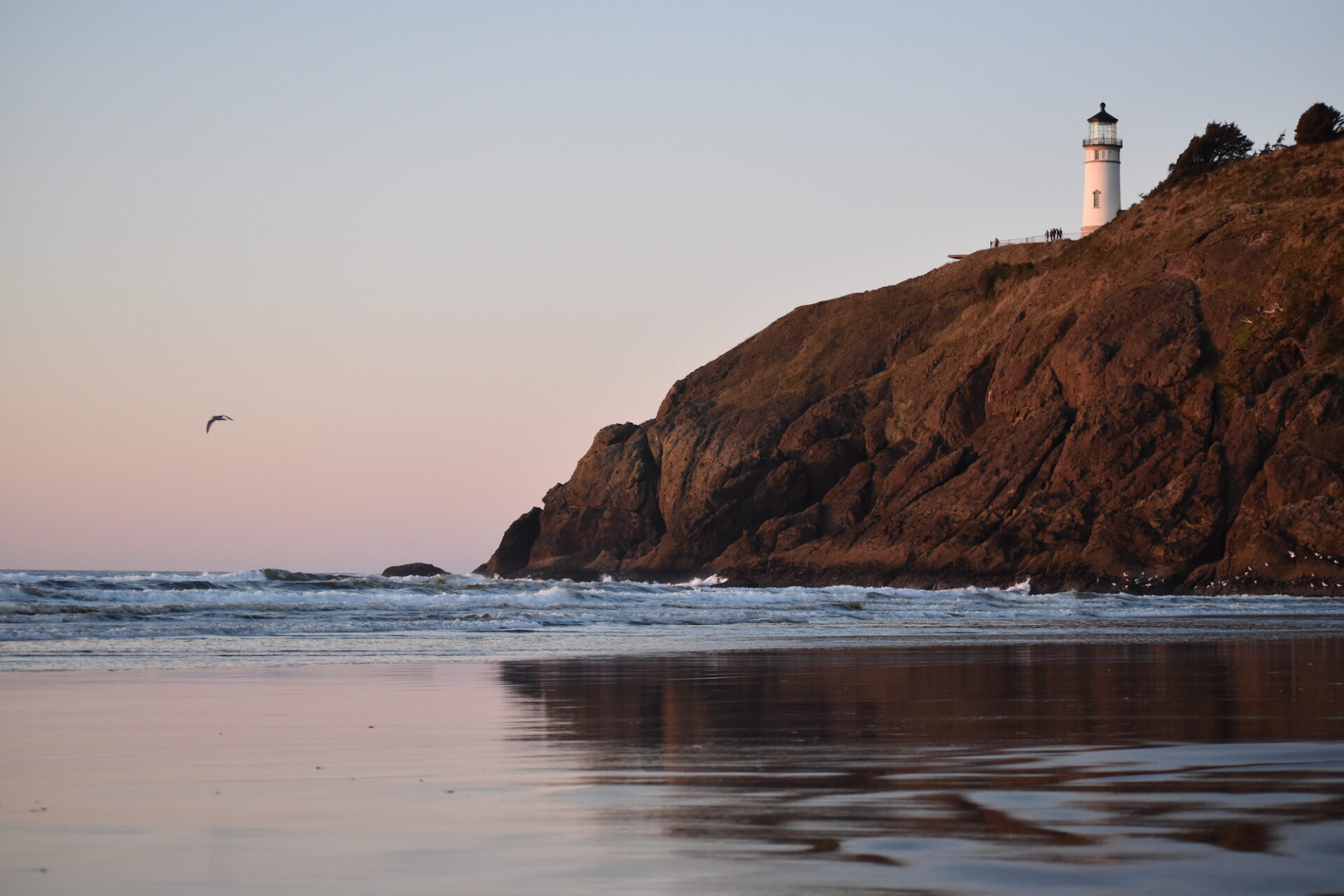Back in November, a friend and her husband living the Airstream life invited me to join them for Thanksgiving. The location? Cape Disappointment State Park on Washington’s southwest coast. I spend so much time in the mountains that it had been well over four years since my last visit to the coast. I excitedly said yes and brought my new rescue pup Hudson along for his first camping trip.
Cape Disappointment has been on my list of places to visit for many years and for a history geek like me, it’s like hitting the lottery. It’s home to two lighthouses, a number of Civil War era batteries, and a world-class interpretive center. Even with all those attractions, the State Park only has eight miles of hiking trails. I was certain I’d need to venture into Oregon or visit neighboring parks to keep myself occupied for my five day stay.
I was wrong!
I traveled no further than 10 miles outside the park and still logged nearly 40 miles of historical sightseeing, beach walking, and exploring. The best part? I got to hear ghost stories! Yep, ghost stories from Washington’s oldest operating hotel in nearby Long Beach. My trip to Cape Disappointment far exceeded all my expectations.

A brief history of Cape Disappointment.
Cape Disappointment is a headland located at the far southwest corner of Washington State where the mighty Columbia River meets the Pacific Ocean. The huge amount of sediment carried by the Columbia creates the treacherous Columbia River Bar, considered one of the most dangerous maritime channels in the world. Since 1792, the bar has sunk over 2,000 large ships and is often called the graveyard of the Pacific. Thanks to the challenging conditions, the Coast Guard Station at Cape Disappointment is the largest search and rescue operation on the Northwest Coast. Crew members respond to as many as 200 calls for assistance each year.
The Cape was first discovered in 1775 by Spanish explorer Bruno de Heceta, who noted a large bay, likely the mouth of a great river. In 1788, the English Captain John Meares attempted to locate Heceta’s river but failed. He dubbed the area Cape Disappointment.
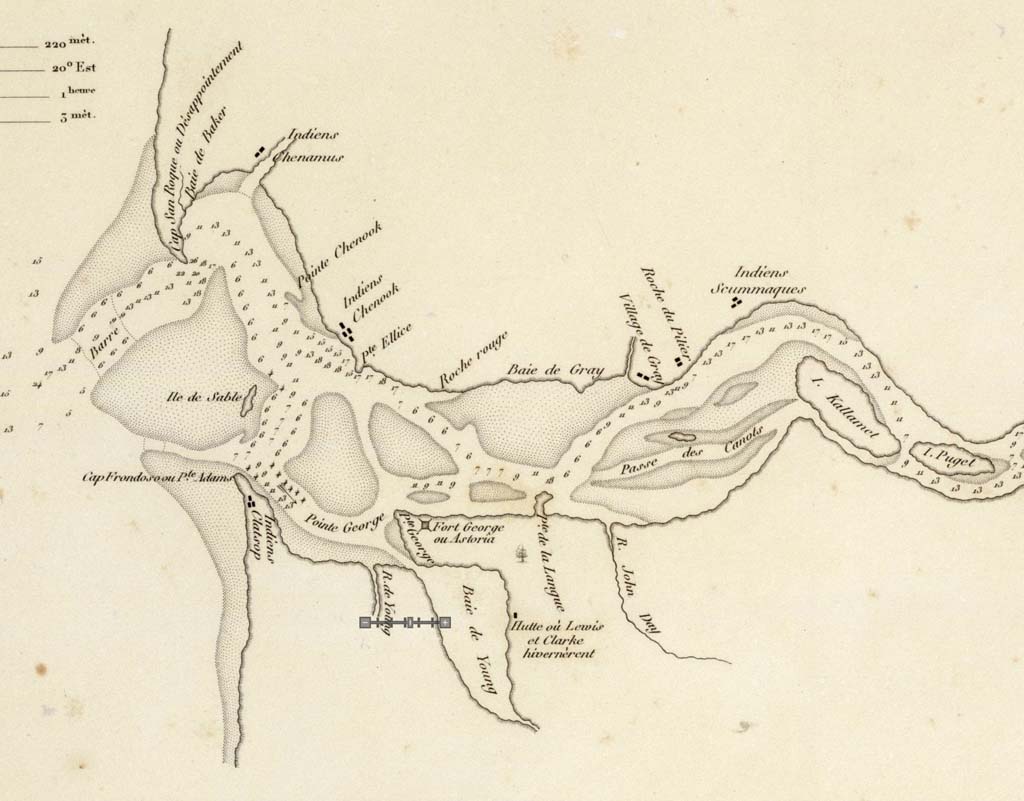
American Captain John Gray successfully navigated the river bar in 1792. In 1805, Lewis and Clark and the Corps of Discovery ended their remarkable expedition to the sea in 1805 along the shores of Cape Disappointment.
A camp was established in 1862 during the American Civil War to protect the northern side of the Columbia River. Many of the bunkers and batteries constructed then still exist today. By 1875 the camp was known as Fort Canby, named after General Edward R. Canby, who was killed in California during a fight with Modoc Indians.

Today, Cape Disappointment State Park, formerly Fort Canby, covers 1,882 acres and is the 15th largest Washington State Park. It’s also one of the most visited. Its landscape is surprisingly diverse, with old-growth forest, freshwater lakes, tidelands, both freshwater and saltwater marshes, and 27 miles of beaches.
Two lighthouses are double the fun.
Cape Disappointment State Park is home to two operating lighthouses: North Head and Cape Disappointment. The latter marks the entrance to the Columbia River and is the oldest operating lighthouse in the Pacific Northwest.
A ship carrying building materials for the Cape Disappointment lighthouse ran aground and sank near the cape in 1853 and the lighthouse wasn’t completed until 1856. Even after Cape Disappointment’s operation, shipwrecks continued because the lighthouse wasn’t visible to ships approaching from the north. Construction of a second lighthouse, North Head, was commissioned two miles to the north in 1893 and completed in 1898.
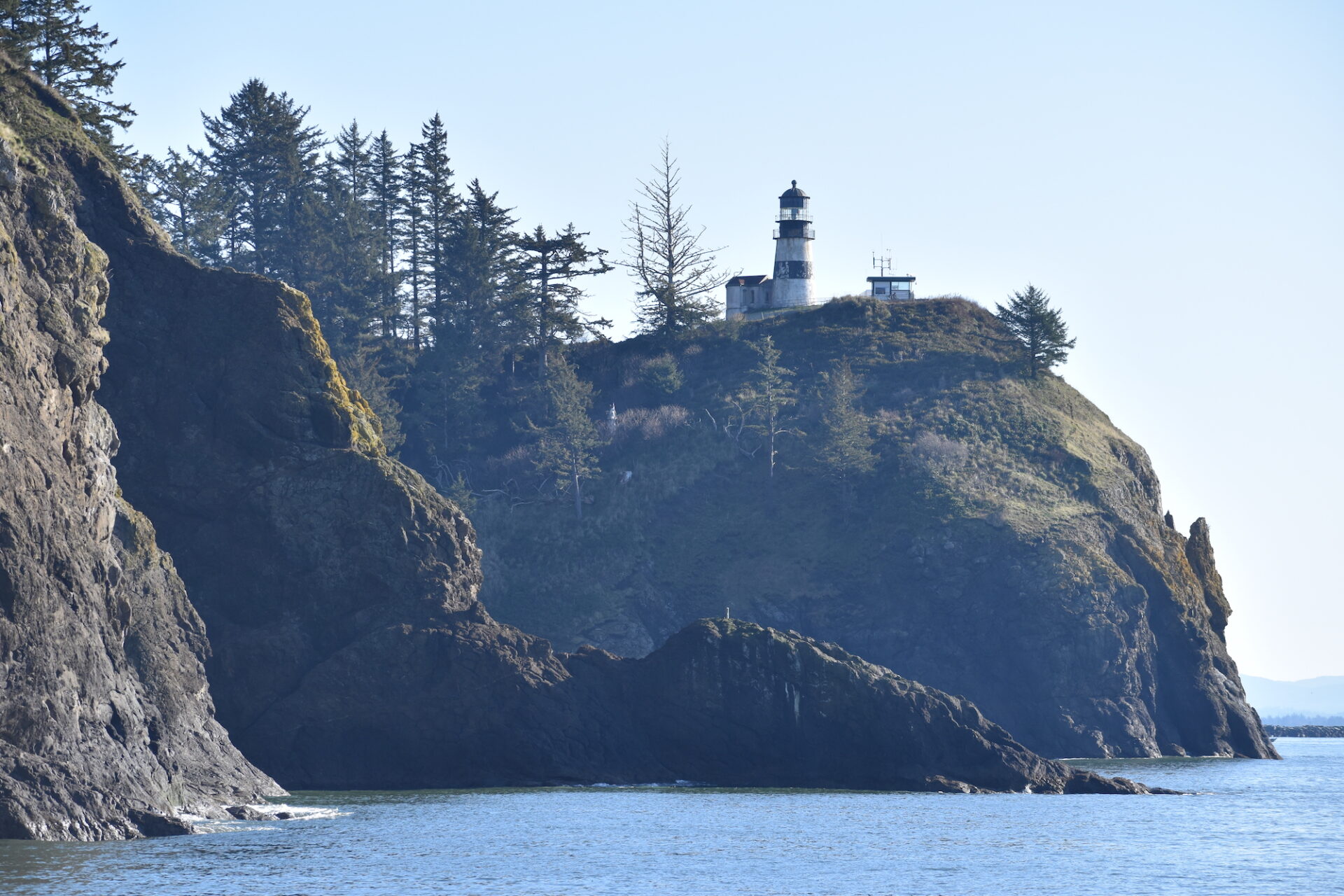
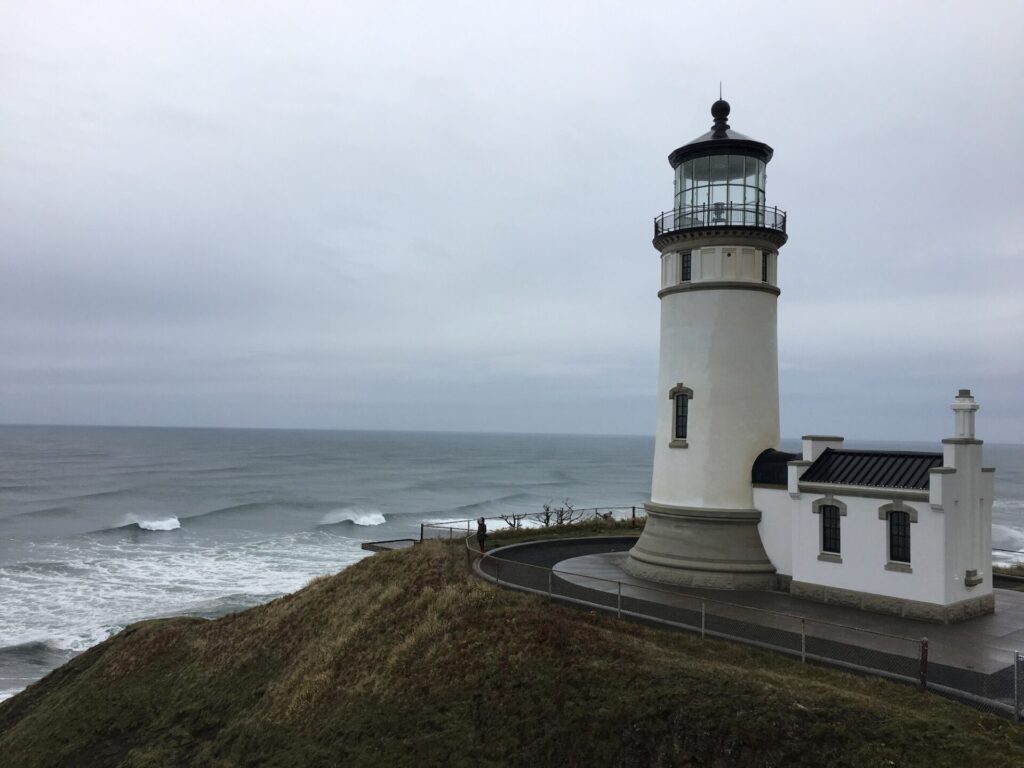
Arriving at Cape Disappointment. Hello beautiful Pacific!
From Seattle, the drive to Cape Disappointment takes about three hours, winding along Capitol State Forest and then down the quiet and scenic Highway 101. There are lots of opportunities to stop in small towns along the way or take a stroll through the Willapa National Wildlife Refuge.
The park was, not surprisingly, busy for a Thanksgiving holiday. A few weeks before my trip I was able to reserve one of the last camp spots open for my entire five day stay. I arrived shortly after my 2:30 check-in time and had plenty of time to set up my camp before hitting the beach with Hudson before sunset.
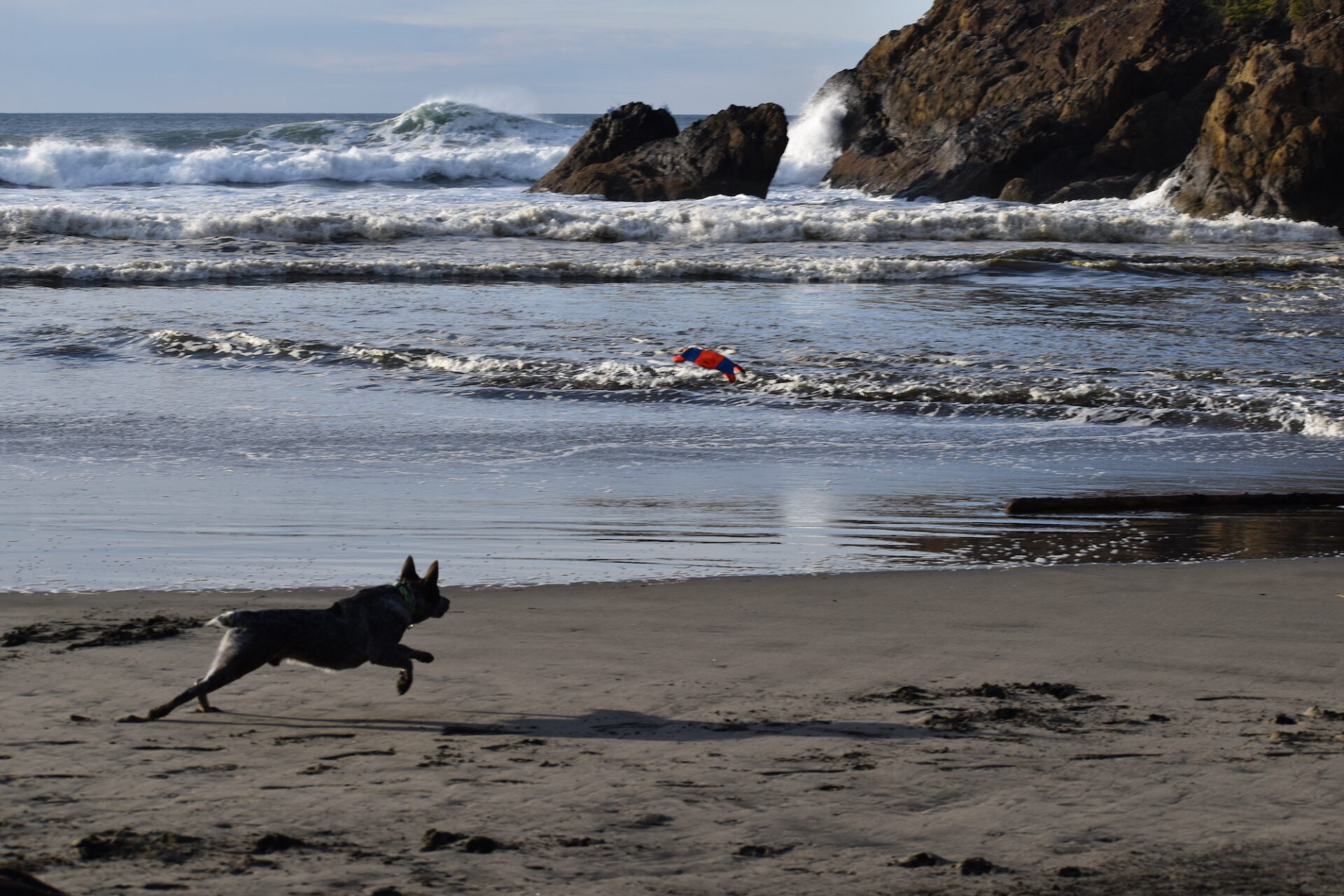
November on the coast is known for big storms that roll in off the Pacific and many flock to Cape Disappointment to photograph impressive crashing waves. Instead of storms on my trip, I enjoyed a rare stretch of sunshine. The price for all that liquid gold? Temps that barely made it above 40s and plummeted into the 20s overnight. Brrrrr! I’m pretty sure though I didn’t take off my puffy or the multiple layers under it even once during the entire trip.
Hudson and I spent our first afternoon running around the gorgeous beach near the campground, walking about a mile and a half south to a jetty and back. With the campground completely full of RVs, we were surprised to have nearly the entire beach all to ourselves. I suppose everyone was tucked away, staying warm, which was just fine by me.
That evening I met my friends in their Airstream for a cozy Thanksgiving dinner with our dogs, grateful for clear weather and good adventure. Before retiring to my tent that evening, clear starry skies beckoned me out for some stargazing. The tide was so far out that I walked, and walked, and walked some more. I must have walked a half mile before finally reaching the oceans edge.
From way out there, under a moonless sky with clear, cold weather, the stars were absolutely breathtaking! I gazed at them until I was frozen to the bone. It didn’t take long for me to realize, as I started the long walk back to the campground, that leaving a light on the shoreline might have been a good idea. I was so far out that I had completely lost track of where exactly I came from. It took me nearly 30 minutes of hunting up and down the shoreline to finally find a trail back to my campsite.
Beach tip: drop a glow stick or light on the shore if you go walking way out there at low tide during a new moon. It’s nearly impossible even with a headlamp to identify where you came from!
Cape Disappointment Lighthouse.
After Thursday’s long drive, I was eager to get my legs moving. Hudson and I hit the beach Friday morning for some frisbee time and then met my friends to walk from the campground to the Cape Disappointment Lighthouse. There aren’t any trails from the campground back to the entrance of the State Park but it’s a short one mile road walk.
From near the park entrance around Waikiki Beach, a trail leads steeply uphill about a half mile to the Lewis and Clark Interpretive Center and the nearby Battery Harvey Allen, built sometime in 1904-1905 as part of the Harbor Defense of the Columbia.
From the Battery, a trail continues north, then loops around to the east past Deadman’s Hollow before climbing up to the Cape Disappointment Lighthouse. Deadman’s Hollow is currently closed due to trail damage and landslides.
While you can’t actually enter or tour the Cape Disappointment Lighthouse, it’s a great spot to bring up a picnic lunch, watch boats, and enjoy the views, which include towering Saddle Mountain and Oregon’s northern Coast Range.

Hiking from the campground all the way to the Cape D lighthouse and back with a few short detours ended up being an eight mile roundtrip venture, well worth the outdoor time.
The amazing Lewis and Clark Interpretive Center.
I admit that although I’m a history geek, I’m not necessarily a big museum kind of person, but the Lewis and Clark Interpretive Center is a must-do. Yes, it does cost $5, but it’s $5 well spent. The exhibit contains an exhaustive timeline of the entire Lewis and Clark journey along with fascinating historical tidbits, interactive exhibits, and a small movie theater with a short film presentation. My favorite exhibit? Trying my hand at loading tiny pieces of cargo into a tiny 1800s replica canoe without tipping it. Let’s just say Lewis and Clark would have certainly kicked me off their expedition.

I recommend setting aside at least an hour or two to peruse the center, which is convenient to visit while you’re visiting the lighthouse. For free, you can browse part of the interpretive center that explains some local history and showcases the huge 6′ x 9′ first order Fresnel lens that illuminated both Cape Disappointment and North Head.
There is a parking lot near the interpretive center with a paved path to the center and the Cape D lighthouse, but it’s a fairly steep half mile walk. The parking lot is small, so if you’re unable to walk very far, it might be worth visiting early or late or during the off-peak season.
Visiting North Head and Beard’s Hollow.
It took me until my third day at the park to finally visit the North Head Lighthouse, which can easily be reached by driving up the North Head Lighthouse Road, parking in the lot, and taking a short, easy walk. But what’s the fun in that? I decided instead to walk from the campground, making my way up the North Head Trail and over to the lighthouse, just under three miles one way.
I walked the entire short lighthouse loop, enjoying the views of an old keeper’s residence, barn, and outbuildings. I also explored the short out-and-back Bell’s View Overlook Trail with an old water tower, a small battery, a great view, and plenty of informational placards. Definitely worth the extra half mile.
The North Head lighthouse offers tours for $2.50 per person, but only from May – September. If you visit in the off-season like me you’re out of luck. I definitely will return for a tour in the future.
After visiting North Head I continued north on the Discovery Trail from the parking lot to Beard’s Hollow, a beautiful beach with huge cliffs and tide pools. The boardwalk from the main parking lot at Beard’s Hollow crosses a freshwater wetland that offers magnificent bird watching. You can follow the boardwalk and continue on the Discovery Trail seven miles to Long Beach if you desire, or take one of the paths leading off the paved trail to the beach.
Again, I was shocked that despite the campground being completely full, I saw very few people at the North Head lighthouse and Hudson and I scored Beard’s Hollow all to ourselves. We played frisbee up and down the beach, found otter tracks, and relaxed with snacks, listening to the beautiful sounds of the ocean.
My little jaunt from the campground up to North Head, onward to Beard’s Hollow and back was about 10 miles.
The Discovery Trail.
On the last full day of my trip, I drove into Long Beach to check out a few miles of the Discovery Trail, which is an 8.5 mile paved biking and walking trail from the Port of Illwaco, through the State Park, all the way to Long Beach. There are a number of places to access the trail. I chose the Sid Snyder Beach Approach that is signed for Gray Whale carvings and gave me an opportunity to walk part of the Long Beach Boardwalk.
At the end of the trail behind the Breakers in Long Beach is Clark’s Tree, a bronze replica marking the place where Clark inscribed his name on a pine tree commemorating the end of the long journey of the Corps of Discovery. It also marks the most northerly point that the Lewis and Clark expedition reached on the Pacific Coast.
The Discovery Trail is a fantastic spot to amble and enjoy the beautiful grassy dunes along the Pacific. Did you know that Long Beach’s 28 miles of sand make it the longest continuous beach in the entire United States.
And finally, ghost tales from the Shelburne Hotel.
And now comes the highlight of my entire trip! On the last evening of our stay, my friends and I met up in town for some dinner and randomly found the Pub at Shelburne Hotel using a quick google search. Boy am I glad we did!
I wrapped up my walk on the Discovery Trail quicker than expected and headed to the Shelburne early to grab a pre-dinner drink. The moment I set foot inside I was captivated by the woodwork, architecture, and beautiful Art Nouveau glass windows. I felt like I had stepped right into the early 1900s.
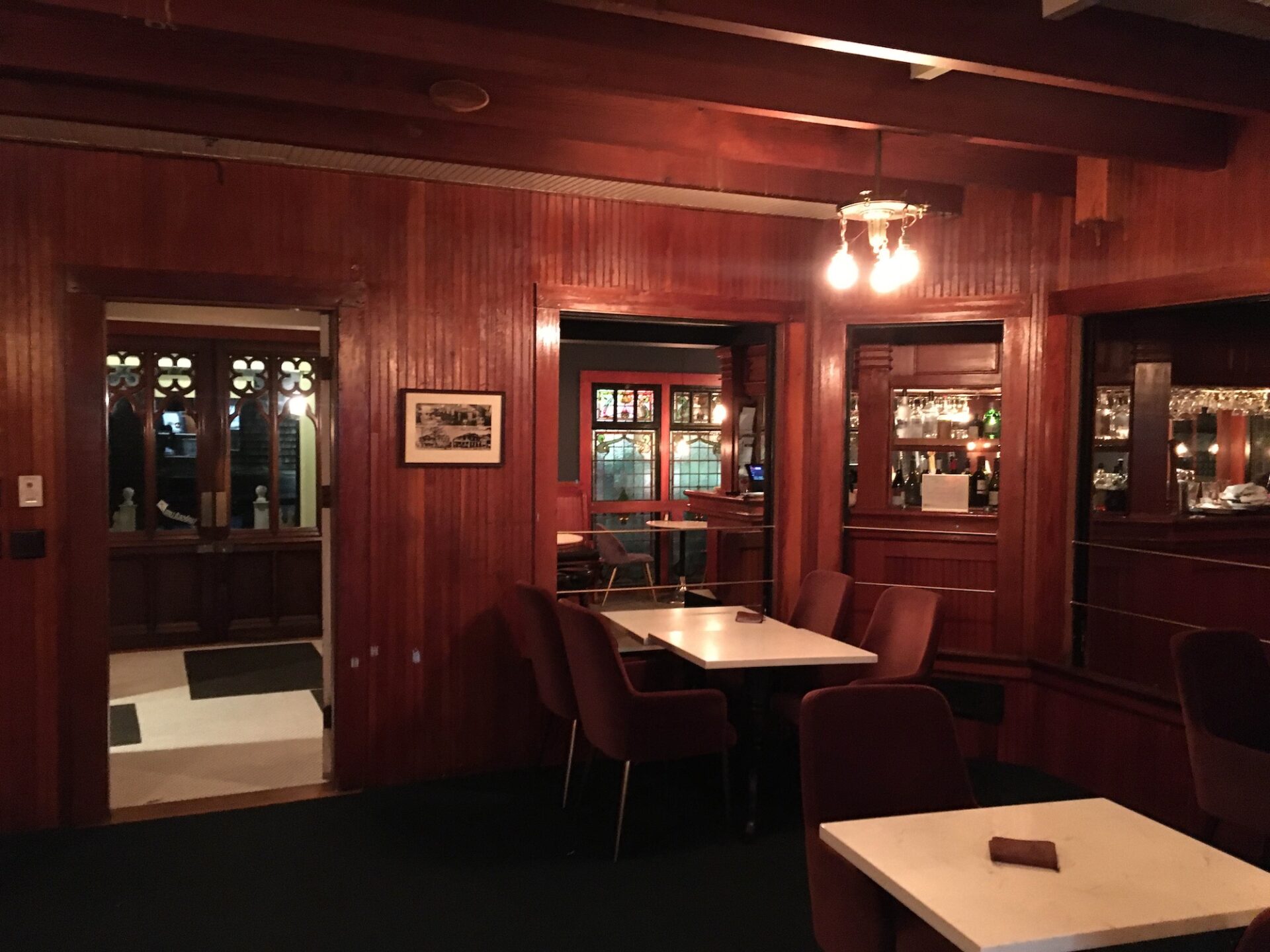
The Shelburne was built in 1896 and is Washington State’s longest continually operating hotel. As I strolled around, enthralled by old photos and antiques, I felt a strange uneasiness. There wasn’t a single other person inside. I wondered if the ghosts of the 1900s were dining around the beautifully set tables, having their own invisible cocktail party.
After a few eerily quiet moments, a woman appeared from the bar, asking me if I’d like a seat. “It’s a strangely quiet night” she told me. It was the Sunday evening after a long holiday weekend and with some possible lowland snow moving into southwest Washington, a lot of folks had packed up and left earlier in the day.
I sat down and grabbed an appetizer and drink while the friendly bartender began telling me all about the history of the Shelburne. The original building was a hotel and boarding house, built by Charles Beaver and named after a grand hotel in Dublin, Ireland. It was a popular stop on the Ilwaco Railroad line, often called the Clamshell Railroad. Beaver and his wife catered to wealthy vacationers from Portland.
Fifteen years later they sold the building, which was originally across the street. The new owners used a team of horses to pull it to its new location and joined it with a larger building. The two buildings remain intact today. And those spectacular glass windows? They were salvaged from a church in England by the 3rd generation of owners.
Then the bartender began telling me ghost stories and well of course, I’m a sucker for ghost stories. I wanted to hear everything! She told me of bumps that come from some of the rooms, strange temperature changes, doors being locked from the inside, and visitors seeing apparitions in the hallways. Once a man at the bar began acting so strangely she was convinced he had been taken over by one of the hotel’s spirits. A psychic who visited the property during the previous owners’ tenure apparently cleaned a well-known haunted room of the original owner’s spirit.
I admit that when the front door opened and my friends arrived, as did some other patrons, I was a little disappointed. My lesson in Shelburne history and ghost stories came to an end. I was so glad I had showed up early. After a wonderful dinner (the menu is fantastic), the hotel workers kindly gave us a tour of some of the rooms, all beautifully remodeled, yet staying true to their 1900s splendor.
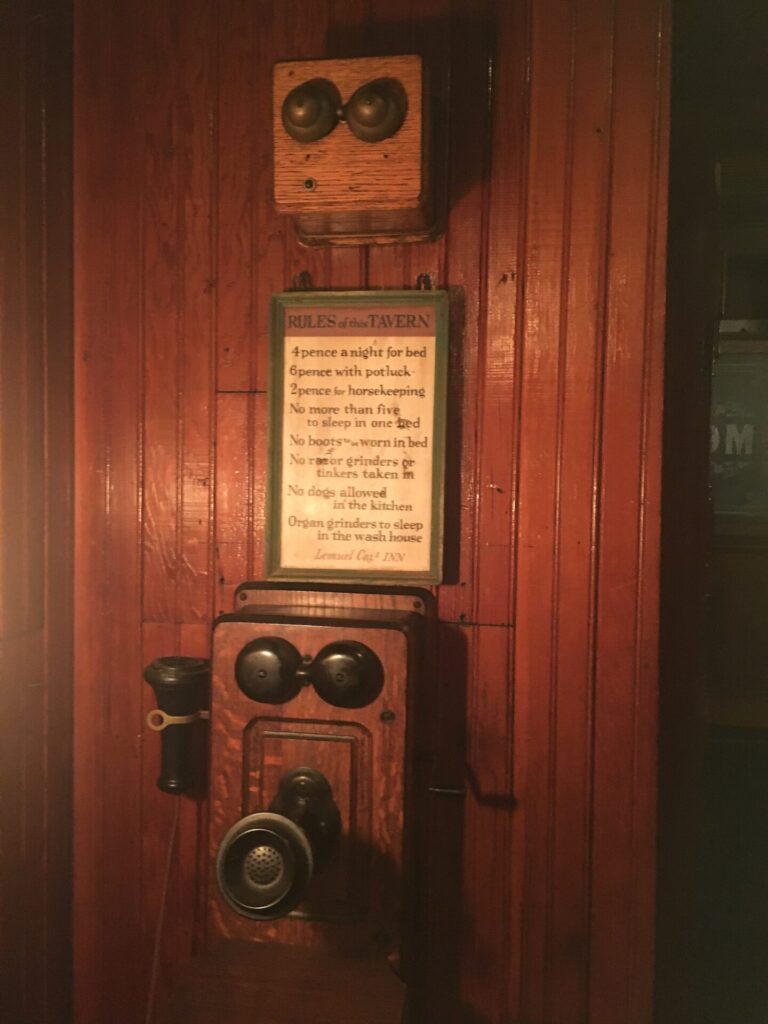
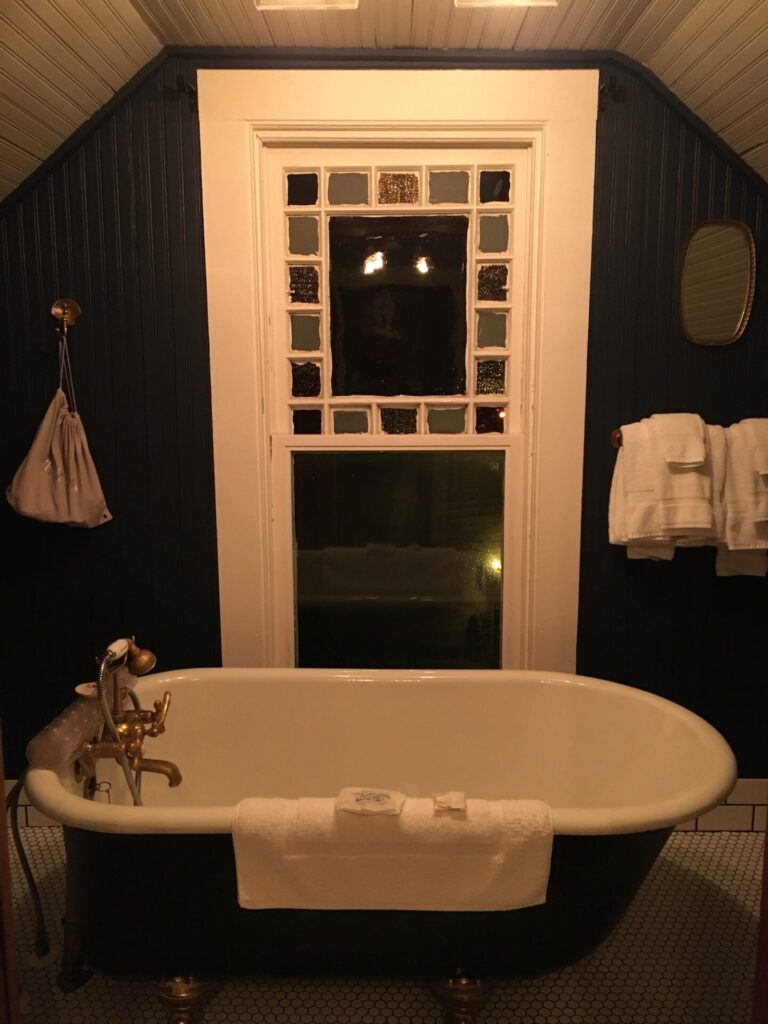
I rather hoped a ghost would show up in my photos, but alas, nothing. If you ever find yourself in Long Beach, a trip the fantastically beautiful and rather eerie Shelburne should certainly be on your agenda.
McKenzie Head and good-bye to the beach.
On my last morning, Hudson and I walked a short ways down the street from the campground and up to McKenzie Head, which is the site of a World War II reinforced concrete gun battery built in 1943-1944. We shared the trail with some noisy white trumpeter swans, honking from the McKenzie Head Lagoon below while enjoying fantastic views out to the Pacific.
We reluctantly returned to pack up camp, stopping by Beard’s Hollow one more time on our way out of the park. Again, we had the entire beach all to ourselves and played frisbee for over an hour.
There’s no doubt I’ll return to Cape Disappointment again. I was surprised that in five days I never even made it the 20 miles north to Leadbetter State Park as I had planned to do. If you visit Cape D, allow a few days. It’s a wonderful area for exploring, even if you spend every day just walking up and down the gorgeous beach!
Additional links and information.
*The North Jetty area of Cape Disappointment is the famous spot for taking wave photos during storms. When I was there, the parking lot was accessible but the U.S. Army Corps of Engineers is currently working on a several-year project to rehabilitate the aging jetties, so walking all the way out and around to Benson Beach currently isn’t possible.
Cape Disappointment State Park.
Check the hours for the Interpretive Center on the park website before you visit and if you really want to do a North Head lighthouse tour, go during the tour season. The beaches of Long Beach and Cape Disappointment are also incredibly dog friendly! Leash laws do apply, but there are so many large stretches of open beach that playing frisbee and sports with a well-trained dog is a-ok.

Cape Disappointment State Park Reservations.
The Park is open year-round and has over 200 accommodations that include tents, RVs, yurts, cabins, and primitive first-come, first-serve hiker/biker camps. This park is popular, so I recommend booking in advance. None of the sites are especially private but during my stay I was one of only a few tents in a sea of RVs. It was quiet and peaceful and my neighbors were all friendly.
Shelburne Hotel.
If you’re in the area, definitely don’t miss the Shelburne! Stop by for brunch or dinner or even consider booking a stay. This building is a gorgeous piece of Washington history and the employees are friendly and welcoming. And they might even tell you ghost stories 😉
Long Beach Peninsula Tourism Site
Long Beach is full of restaurants, shops, and attractions. I admit that I spent nearly all my time in the park, so I didn’t see as much as the local area as I would have liked, but the Tourism Bureau has a site full of great information including tide tables, events, maps and guides.
Want to read more about the Shelburne ghost stories?
Check out this great article in the Chinook Observer.
